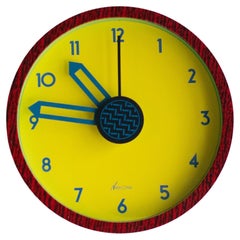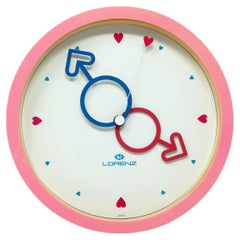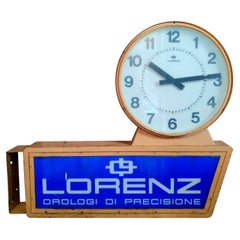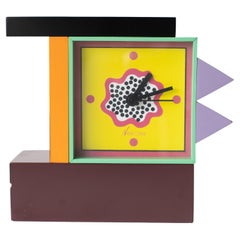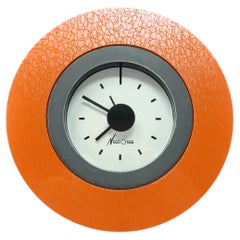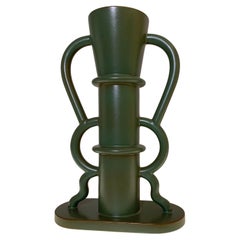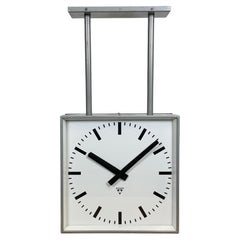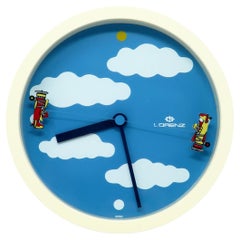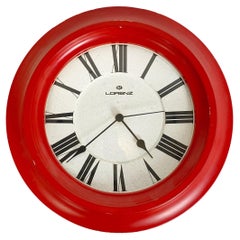Lorenz Clocks
to
7
7
2
5
2
2
1
5
3
1
1
3
2
3
3
Height
to
Width
to
7
7
7
5
68
51
45
39
Creator: Lorenz
Neos Wall Clock 2 George Sowden Nathalie du Pasquier Postmodern
By Nathalie du Pasquier, Memphis Milano, Lorenz, George Sowden
Located in Shibuya-ku, Tokyo
Neos clock designed by George Sowden and Nathalie du Pasquier in the 80s. Neos is the brand run by Lorenz clock company in Italy. They were designed a lot o...
Category
1980s Italian Post-Modern Vintage Lorenz Clocks
Materials
Plastic
1980s Pink Heart Wall Clock by Lorenz
By Lorenz
Located in Brooklyn, NY
A fun round postmodern Lorenz wall clock with multi-color accents from Japan. A pink case, white face, red and blue heart hands, red heart second hand, and red and blue hearts for n...
Category
Late 20th Century Post-Modern Lorenz Clocks
Materials
Plastic
Large Double-Sided Advertising Street Clock "Lorenz" Watches, 1960s
By Lorenz
Located in taranto, IT
large and rare double-sided "flag" advertising street clock Lorenz watches, original from the 1960s, "Bg" brand, entirely made of iron and equipped with a...
Category
1960s Vintage Lorenz Clocks
Materials
Metal
Neos table Clock George Sowden Nathalie du Pasquier Postmodern
By Nathalie du Pasquier, George Sowden, Lorenz
Located in Shibuya-ku, Tokyo
Neos clock designed by George Sowden and Nathalie du Pasquier.
One of some table clock variations.
Category
1980s Italian Post-Modern Vintage Lorenz Clocks
Materials
Plastic, Acrylic
Postmodern Wall Clock by Nathalie du Pasquier & George Sowden for Neos
By Nathalie du Pasquier, George Sowden, Lorenz
Located in Brooklyn, NY
An amazing orange and gray wall clock designed by Memphis Group founding members George Sowden and Nathalie du Pasquier for Neos of Lorenz. Orange pla...
Category
Late 20th Century Post-Modern Lorenz Clocks
Materials
Glass, Plastic
Italian Mid-Century Spherical Plastic Blue Table Clock Boule by Lorenz, 1960s
By Lorenz
Located in MIlano, IT
Italian mid-century Spherical plastic blue table clock model Boule by Lorenz, 1960s
Boule model table clock, the structure is in spherical shape in m...
Category
1960s Italian Mid-Century Modern Vintage Lorenz Clocks
Materials
Metal
Vintage 1980s Lorenz Action Art Table/Wall Clock
By Lorenz
Located in Brooklyn, NY
Bringing a touch of Space Age design flair to your space, this mid-century clock features a kinetic sphere design, with the clock's hands rotating within the chrome frame. Cleverly designed so that it can both be used on a table as a desk clock and can be hung to be a wall clock.
This clock was made or licensed by several companies, including "Jeco", "Yachiyo", and others. This piece is made by Lorenz Action Art...
Category
Late 20th Century Post-Modern Lorenz Clocks
Materials
Metal
Related Items
Ceramic Vase by Nathalie Du Pasquier for Alessio Sarri Editions, Italy
By Nathalie du Pasquier
Located in Milan, Italy
Ceramic vase designed by Nathalie Du Pasquier and produced by Alesso Sarri Editions, Italy. Signed.
Biography
Nathalie du Pasquier (b. 1957, Bordeaux, France) worked as a designe...
Category
21st Century and Contemporary Italian Modern Lorenz Clocks
Materials
Ceramic
$1,631
H 13 in W 8.67 in D 3.94 in
Large Square Industrial Double-Sided Factory Clock from Pragotron, 1960s
By Pragotron
Located in Kojetice, CZ
This square double-sided railway, school or factory clock was produced by Pragotron, in former Czechoslovakia, during the 1970s. The piece features a grey hammerpaint metal body, a c...
Category
1970s Czech Industrial Vintage Lorenz Clocks
Materials
Aluminum, Iron
$814
H 33.08 in W 17.33 in D 7.09 in
Neos Lorenz du Pasquier & Sowden Postmodern Clock
By George Sowden, Nathalie du Pasquier
Located in Chicago, IL
Neos Lorenz du Pasquier & Sowden Postmodern Clock
A black and white, bullseye-like design plastic postmodern wall clock with yellow hands and numbers designed by Nathalie du Pasquier...
Category
1980s Italian Post-Modern Vintage Lorenz Clocks
Materials
Plastic
Wall Clock Leather Brass, 1960s
Located in Hausmannstätten, AT
A wall clock made of leather and brass manufactured in midcentury, circa 1960.
The clock hangs with golden toned cords on a brass knob.
A removable key is used for winding the move...
Category
1960s Italian Mid-Century Modern Vintage Lorenz Clocks
Materials
Brass
Postmodern Howard Miller George Nelson 1984 Olympus Table Clock "Tempo 21"
By George Nelson, Howard Miller
Located in Kansas City, MO
Rare "Olympus" table clock by Howard Miller Clock Company. From the 1984 "Tempo 21" collection. The circular red clock face is upheld by a green pyramid base...
Category
1980s American Post-Modern Vintage Lorenz Clocks
Materials
Aluminum
$1,250
H 14 in W 8.25 in D 14 in
Onion Ceramic Fruit Bowl by Nathalie du Pasquier for Memphis Milano Collection
By Memphis Milano, Nathalie du Pasquier
Located in La Morra, Cuneo
Onion ceramic fruit bowl by Nathalie Du Pasquier for Memphis Milano collection
Additional information:
Ceramic fruit-bowl.
Collection: Memphis Milano
Designer...
Category
2010s Lorenz Clocks
Materials
Ceramic
$510 / item
H 3.15 in W 9.85 in D 11.82 in
Large Industrial Square Double Sided Factory Wall Clock from Pragotron, 1970s
By Pragotron
Located in Kojetice, CZ
This square double sided railway, school or factory wall clock was produced by Pragotron, in former Czechoslovakia, during the 1970s. The piece features a grey metal body, a dark gre...
Category
1970s Czech Industrial Vintage Lorenz Clocks
Materials
Aluminum, Iron
$814 / item
H 17.33 in W 22.84 in D 7.09 in
Carrot Flower Vase, by Nathalie du Pasquier from Memphis Milano
By Memphis Group, Memphis Milano, Nathalie du Pasquier
Located in La Morra, Cuneo
The Carrot ceramic vase was originally designed by Nathalie du Pasquier in 1985 for Memphis Milano. The transmuted ceramic arises in geometric compositions ...
Category
21st Century and Contemporary Italian Modern Lorenz Clocks
Materials
Ceramic
Ceramic Vase by Nathalie Du Pasquier for Alessio Sarri Editions, Italy
By Nathalie du Pasquier
Located in Milan, Italy
Ceramic vase designed by Nathalie Du Pasquier and produced by Alesso Sarri Ceramiche, Italy. Signed.
Biography
Nathalie du Pasquier (b. 1957, Bordeaux, France) worked as a design...
Category
21st Century and Contemporary Italian Modern Lorenz Clocks
Materials
Ceramic
$1,631
H 11.82 in W 9.85 in D 5.91 in
1980s Postmodern White Rexite Zero 980 Wall Clock
By Barbieri e Marianelli, Rexite
Located in Brooklyn, NY
Designed by Raul Barbieri and Giorgio Marianelli for Rexite in 1981, this Zero 980 wall clock has a striking white on white colorway. White plastic case, white hands, and raised whit...
Category
Late 20th Century Post-Modern Lorenz Clocks
Materials
Plastic
Vintage Black School Wall Clock from Lathem, 1980s
Located in Kojetice, CZ
This wall clock was produced by Lathem Time Recorder Co. Atlanta, Georgia in United states during the 1980s. It features a black metal frame, a metal dial and a convex clear glass co...
Category
Late 20th Century American Industrial Lorenz Clocks
Materials
Iron
Swatch Wall Clock Maxi 1980s
By Swatch
Located in Čelinac, BA
Swatch wall clock maxi 1980s
Category
1980s Swiss Mid-Century Modern Vintage Lorenz Clocks
Materials
Plastic
Previously Available Items
Postmodern Airplane Wall Clock by Lorenz
By Lorenz
Located in Brooklyn, NY
A round 1980s wall clock by Lorenz with white case, blue face with white clouds, black hour and minute hands, and second hand with two bi-planes on e...
Category
Late 20th Century Post-Modern Lorenz Clocks
Materials
Plastic
Italian Mid-Century Modern Round Red Wall Clock by Lorenz, 1970s
By Lorenz
Located in MIlano, IT
Italian Mid-Century Modern round red wall clock by Lorenz, 1970s
Round wall clock in red painted metal with white dial and black numbers. Made by Lorena...
Category
1970s Italian Modern Vintage Lorenz Clocks
Materials
Metal
Italian Mid-Century Spherical Plastic Green Table Clock Boule by Lorenz, 1960s
By Lorenz
Located in MIlano, IT
Italian mid-century Spherical plastic green table clock model Boule by Lorenz, 1960s
Boule model table clock, the structure is in spherical shape in metal and plastic. The dial is r...
Category
1960s Italian Mid-Century Modern Vintage Lorenz Clocks
Materials
Metal
H 7.88 in W 7.49 in D 7.49 in
Neos Clock George Sowden Nathalie du Pasquier Postmodern
By Nathalie du Pasquier, Lorenz, George Sowden
Located in Shibuya-ku, Tokyo
Neos clock designed by George Sowden and Nathalie du Pasquier.
Working with original box.
Category
1980s Italian Post-Modern Vintage Lorenz Clocks
Materials
Plastic, Acrylic
Lorenz clocks for sale on 1stDibs.
Lorenz clocks are available for sale on 1stDibs. These distinctive items are frequently made of plastic and are designed with extraordinary care. There are many options to choose from in our collection of Lorenz clocks, although white editions of this piece are particularly popular. Many of the original clocks by Lorenz were created in the modern style in italy during the 20th century. If you’re looking for additional options, many customers also consider clocks by George Sowden, and Nathalie du Pasquier. Prices for Lorenz clocks can differ depending upon size, time period and other attributes — on 1stDibs, these items begin at $176 and can go as high as $7,763, while a piece like these, on average, fetch $790.
